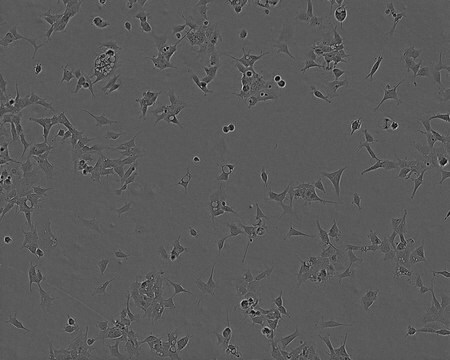MA104
NOTE: Both the cell line and DNA from the cell line may be available for this product. Please choose -1VL or VIAL for cells, or -DNA-5UG for DNA, 85102918, African green monkey kidney, Epithelial
About This Item
Produits recommandés
Source biologique
African green monkey kidney
Description
Convention on the International Trade in Endangered Species of Wild Fauna and Flora (CITES)
Conditionnement
tube of 5 μg 85102918-DNA-5UG
pkg of vial of cells 85102918-1VL
Mode de croissance
Adherent
Caryotype
Not specified
Morphologie
Epithelial
Récepteurs
Not specified
Vous recherchez des produits similaires ? Visite Guide de comparaison des produits
Origine de la lignée cellulaire
Description de la lignée cellulaire
Please note: The species of origin of the MA104 cell line has been shown to be different from that claimed by the originators.
Whitaker & Hayward (1985) found the cell line to originate from an African green monkey and not a Rhesus macaque as was originally claimed. Whitaker AM and Hayward CJ (1985). The characterization of three monkey kidney cell lines. Develop. Biol. Standard. Vol 60: 125-131. PMID: 4043530. Abstract: Three monkey kidney cell lines, Vero, GL-V3 and MA-104 were subjected to karyological analysis to determine their chromosomal stability and to confirm their species of origin. Although the lines were shown to be relatively stable throughout all of the passage levels that were tested, the species of origin of one of them was found to be different from that claimed by the originators. This finding was supported by data from isoenzyme studies.
Milieu de culture
Procédure de repiquage
Autres remarques
Faites votre choix parmi les versions les plus récentes :
Certificats d'analyse (COA)
It looks like we've run into a problem, but you can still download Certificates of Analysis from our Documents section.
Si vous avez besoin d'assistance, veuillez contacter Service Clients
Déjà en possession de ce produit ?
Retrouvez la documentation relative aux produits que vous avez récemment achetés dans la Bibliothèque de documents.
Notre équipe de scientifiques dispose d'une expérience dans tous les secteurs de la recherche, notamment en sciences de la vie, science des matériaux, synthèse chimique, chromatographie, analyse et dans de nombreux autres domaines..
Contacter notre Service technique


